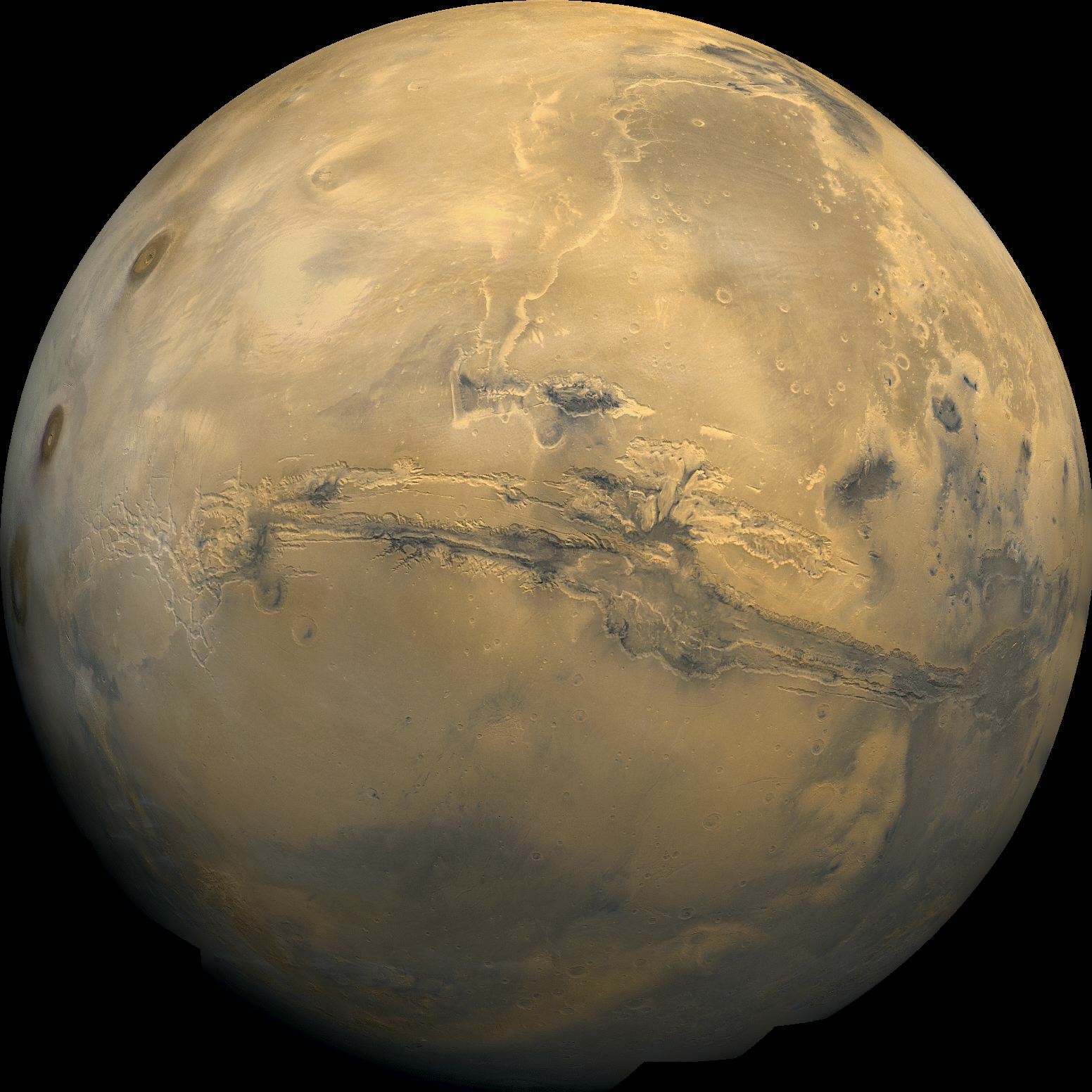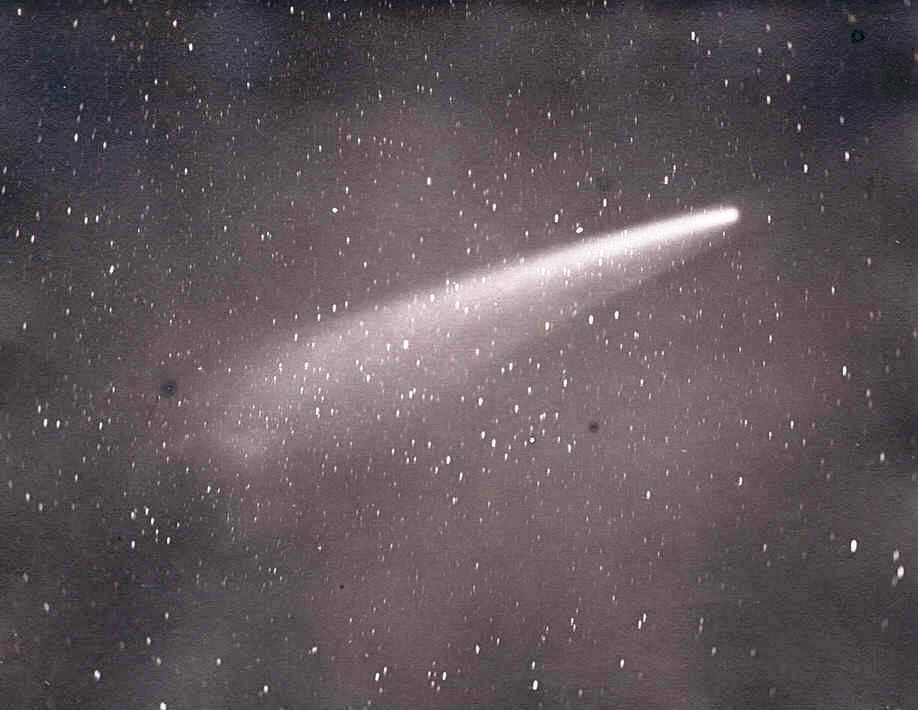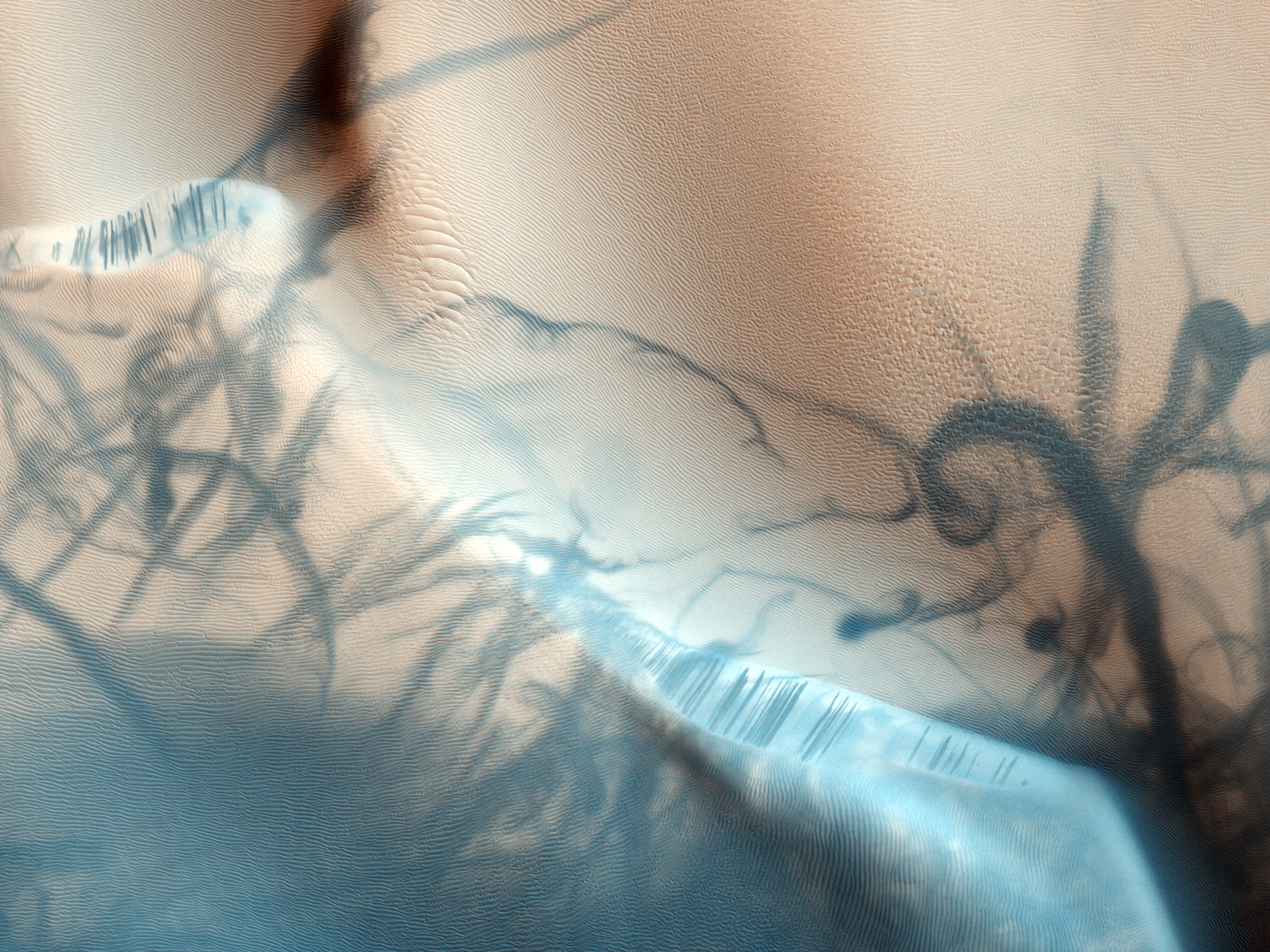|
Eddie (crater)
Eddie is a crater in the Elysium quadrangle of Mars. It is 89 km in diameter and was named after Lindsay Eddie, a South African astronomer (1845–1913). Impact craters generally have a rim with ejecta around them, in contrast volcanic craters usually do not have a rim or ejecta deposits. As craters get larger (greater than 10 km in diameter) they usually have a central peak, as this crater has. The peak is caused by a rebound of the crater floor following the impact. It contains material uplifted from beneath the surface. The InSight Mars lander landed south and west of Eddie crater in 2018. Elysium map.JPG, Map of Elysium quadrangle. Elysium Mons and Albor Tholus are large volcanoes. Eddie crater is at the left. Wikieddie.jpg, Eddie crater, as seen by CTX camera on MRO Eddie Crater central peak.JPG, Central peak of Eddie crater, as seen by HiRISE. Eddie crater.jpg, A topographic map using Mars Orbiter Laser Altimeter (MOLA) data. This map shows the elevation o ... [...More Info...] [...Related Items...] OR: [Wikipedia] [Google] [Baidu] |
Viking Program
The ''Viking'' program consisted of a pair of identical American space probes, ''Viking 1'' and ''Viking 2'', which landed on Mars in 1976. Each spacecraft was composed of two main parts: an orbiter designed to photograph the surface of Mars from orbit, and a lander designed to study the planet from the surface. The orbiters also served as communication relays for the landers once they touched down. The Viking program grew from NASA's earlier, even more ambitious, Voyager Mars program, which was not related to the successful Voyager deep space probes of the late 1970s. ''Viking 1'' was launched on August 20, 1975, and the second craft, ''Viking 2'', was launched on September 9, 1975, both riding atop Titan IIIE rockets with Centaur upper stages. ''Viking 1'' entered Mars orbit on June 19, 1976, with ''Viking 2'' following on August 7. After orbiting Mars for more than a month and returning images used for landing site selection, the orbiters and landers detached; the lander ... [...More Info...] [...Related Items...] OR: [Wikipedia] [Google] [Baidu] |
Mars
Mars is the fourth planet from the Sun and the second-smallest planet in the Solar System, only being larger than Mercury (planet), Mercury. In the English language, Mars is named for the Mars (mythology), Roman god of war. Mars is a terrestrial planet with a thin atmosphere (less than 1% that of Earth's), and has a crust primarily composed of elements similar to Earth's crust, as well as a core made of iron and nickel. Mars has surface features such as impact craters, valleys, dunes and polar ice caps. It has two small and irregularly shaped moons, Phobos (moon), Phobos and Deimos (moon), Deimos. Some of the most notable surface features on Mars include Olympus Mons, the largest volcano and List of tallest mountains in the Solar System, highest known mountain in the Solar System and Valles Marineris, one of the largest canyons in the Solar System. The North Polar Basin (Mars), Borealis basin in the Northern Hemisphere covers approximately 40% of the planet and may be a la ... [...More Info...] [...Related Items...] OR: [Wikipedia] [Google] [Baidu] |
Lindsay Eddie
Lindsay Atkins Eddie FRAS (c. 1845 – 13 October 1913) was a South-African amateur astronomer, known for his observations of Venus, Mercury and Mars and 21 comets. He was elected a fellow of the Royal Astronomical Society in 1880. He saw active military service in South Africa and his final rank was that of a Major. Personal life Eddie was the son of an army Surgeon, William Cruikshank Eddie and Sarah Eddie (née Kaye). He had one brother and one sister. He grew up in Grahamstown and joined the civil service of the Cape of Good Hope in 1878. By 1892 he was clerk to judge Jones of the Eastern District Court, where he and W.G. Atherstone were asked to analyse a judgement of a libel case that a jury had been unable to decide. The case revolved around W.B. Shaw who had accused dean Williams of St Michael and St George Cathedral, Grahamstown of being a liar. He served in the military for 20 years. In 1876 he commanded the Grahamstown Rifles during an invasion of Xhosas just pr ... [...More Info...] [...Related Items...] OR: [Wikipedia] [Google] [Baidu] |
Elysium Quadrangle
The Elysium quadrangle is one of a series of 30 quadrangle maps of Mars used by the United States Geological Survey (USGS) Astrogeology Research Program. The Elysium quadrangle is also referred to as MC-15 (Mars Chart-15). The name Elysium refers to a place of reward (Heaven), according to Homer in the Odyssey. The Elysium quadrangle covers the area between 180° to 225° west longitude and 0° to 30° north latitude on Mars. The northern part of Elysium Planitia, a broad plain, is in this quadrangle. The Elysium quadrangle includes a part of Lucus Planum. A small part of the Medusae Fossae Formation lies in this quadrangle. The largest craters in this quadrangle are Eddie, Lockyer, and Tombaugh. The quadrangle contains the major volcanoes Elysium Mons and Albor Tholus, part of a volcanic province of the same name, as well as river valleys—one of which, Athabasca Valles may be one of the youngest on Mars. On the east side is an elongated depression called Orcus Pat ... [...More Info...] [...Related Items...] OR: [Wikipedia] [Google] [Baidu] |
University Of Arizona Press
The University of Arizona Press, a publishing house founded in 1959 as a department of the University of Arizona, is a nonprofit publisher of scholarly and regional books. As a delegate of the University of Arizona to the larger world, the Press publishes the work of scholars wherever they may be, concentrating upon scholarship that reflects the special strengths of the University of Arizona, Arizona State University, and Northern Arizona University. The Press publishes about fifty books annually and has some 1,400 books in print. These include scholarly titles in American Indian studies, anthropology, archaeology, environmental studies, geography, Chicano studies, history, Latin American studies, and the space sciences. The UA Press has award-winning books in more than 30 subject areas. The UA Press also publishes general interest books on Arizona and the Southwest borderlands. In addition, the Press publishes books of personal essays, such as Nancy Mairs's ''Plaintext'' and tw ... [...More Info...] [...Related Items...] OR: [Wikipedia] [Google] [Baidu] |
InSight
Insight is the understanding of a specific cause and effect within a particular context. The term insight can have several related meanings: *a piece of information *the act or result of understanding the inner nature of things or of seeing intuitively (called noesis in Greek) *an introspection *the power of acute observation and deduction, discernment, and perception, called intellection or noesis *An understanding of cause and effect based on the identification of relationships and behaviors within a model, context, or scenario (see artificial intelligence) An insight that manifests itself suddenly, such as understanding how to solve a difficult problem, is sometimes called by the German word '' Aha-Erlebnis''. The term was coined by the German psychologist and theoretical linguist Karl Bühler. It is also known as an epiphany, eureka moment or (for cross word solvers) the penny dropping moment (PDM). Sudden sickening realisations often identify a problem rather than solving i ... [...More Info...] [...Related Items...] OR: [Wikipedia] [Google] [Baidu] |
Elysium Mons
Elysium Mons is a volcano on Mars located in the volcanic province Elysium, at , in the Martian eastern hemisphere. It stands about above its base, and about above the Martian ''datum'', making it the third tallest Martian mountain in terms of relief and the fourth highest in elevation. Its diameter is about , with a summit caldera about across. It is flanked by the smaller volcanoes Hecates Tholus to the northeast, and Albor Tholus to the southeast. Discovery Elysium Mons was discovered in 1972 in images returned by the Mariner 9 orbiter. Terrestrial analog The terrestrial volcano Emi Koussi (in Chad) has been studied as an analog of Elysium Mons. The two shield volcanoes have summit calderas of similar size, but Elysium Mons is 3.5 times larger in diameter and 6 times higher than its counterpart on Earth. Possible source of nakhlites A 6.5 km diameter crater at 29.674 N, 130.799 E, in the volcanic plains to the northwest of Elysium Mons has been identified as a possibl ... [...More Info...] [...Related Items...] OR: [Wikipedia] [Google] [Baidu] |
Albor Tholus
Albor Tholus is an extinct volcano in the volcanic province Elysium on Mars. It lies south of the neighbouring volcanoes Elysium Mons and Hecates Tholus. Albor Tholus is 4.5 kilometres high and has a diameter of 160 km at its base. Its large caldera, having a diameter of 30 km and a depth of 3 km, is deep compared to calderas on the Earth. The elevation of the lowest level of the caldera is the same as the base of the volcano; however, the original lower slopes of Albor Tholus may have been covered by lava flows from its larger neighbor, Elysium Mons. Evaluations by the Mars probe Mars Express ''Mars Express'' is a space exploration mission being conducted by the European Space Agency (ESA). The ''Mars Express'' mission is exploring the planet Mars, and is the first planetary mission attempted by the agency. "Express" originally ref ... found that the volcanoes of the Elysium region were active over long periods. Image:MOLA albor tholus.jpg, Topography of Albo ... [...More Info...] [...Related Items...] OR: [Wikipedia] [Google] [Baidu] |
Mars Reconnaissance Orbiter
''Mars Reconnaissance Orbiter'' (MRO) is a spacecraft designed to study the geology and climate of Mars, provide reconnaissance of future landing sites, and relay data from surface missions back to Earth. It was launched on August 12, 2005, and reached Mars on March 10, 2006. In November 2006, after five months of aerobraking, it entered its final science orbit and began its primary science phase. The cost to develop and operate MRO through the end of its prime mission in 2010 was . The spacecraft continues to operate at Mars, far beyond its intended design life. Due to its critical role as a high-speed data-relay for ground missions, NASA intends to continue the mission as long as possible, at least through the late 2020s. Pre-launch After the twin failures of the ''Mars Climate Orbiter'' and the Mars Polar Lander missions in 1999, NASA reorganized and replanned its Mars Exploration Program. In October 2000, NASA announced its reformulated Mars plans, which reduced the numb ... [...More Info...] [...Related Items...] OR: [Wikipedia] [Google] [Baidu] |
HiRISE
High Resolution Imaging Science Experiment is a camera on board the ''Mars Reconnaissance Orbiter'' which has been orbiting and studying Mars since 2006. The 65 kg (143 lb), US$40 million instrument was built under the direction of the University of Arizona's Lunar and Planetary Laboratory by Ball Aerospace & Technologies Corp. It consists of a 0.5m (19.7 in) aperture reflecting telescope, the largest so far of any deep space mission, which allows it to take pictures of Mars with resolutions of 0.3m/pixel (1ft/pixel), resolving objects below a meter across. HiRISE has imaged Mars exploration rovers on the surface, including the ''Opportunity'' rover and the ongoing ''Curiosity'' mission. History In the late 1980s, of Ball Aerospace & Technologies began planning the kind of high-resolution imaging needed to support sample return and surface exploration of Mars. In early 2001 he teamed up with Alfred McEwen of the University of Arizona to propose such a c ... [...More Info...] [...Related Items...] OR: [Wikipedia] [Google] [Baidu] |
Areoid
The gravity of Mars is a natural phenomenon, due to the law of gravity, or gravitation, by which all things with mass around the planet Mars are brought towards it. It is weaker than Earth's gravity due to the planet's smaller mass. The average gravitational acceleration on Mars is 3.72076 ms−2 (about 38% of that of Earth) and it varies. In general, topography-controlled isostasy drives the short wavelength free-air gravity anomalies. At the same time, convective flow and finite strength of the mantle lead to long-wavelength planetary-scale free-air gravity anomalies over the entire planet. Variation in crustal thickness, magmatic and volcanic activities, impact-induced Moho-uplift, seasonal variation of polar ice caps, atmospheric mass variation and variation of porosity of the crust could also correlate to the lateral variations. Over the years models consisting of an increasing but limited number of spherical harmonics have been produced. Maps produced have included free ... [...More Info...] [...Related Items...] OR: [Wikipedia] [Google] [Baidu] |
Impact Crater
An impact crater is a circular depression in the surface of a solid astronomical object formed by the hypervelocity impact of a smaller object. In contrast to volcanic craters, which result from explosion or internal collapse, impact craters typically have raised rims and floors that are lower in elevation than the surrounding terrain. Lunar impact craters range from microscopic craters on lunar rocks returned by the Apollo Program and small, simple, bowl-shaped depressions in the lunar regolith to large, complex, multi-ringed impact basins. Meteor Crater is a well-known example of a small impact crater on Earth. Impact craters are the dominant geographic features on many solid Solar System objects including the Moon, Mercury, Callisto, Ganymede and most small moons and asteroids. On other planets and moons that experience more active surface geological processes, such as Earth, Venus, Europa, Io and Titan, visible impact craters are less common because they become eroded ... [...More Info...] [...Related Items...] OR: [Wikipedia] [Google] [Baidu] |








